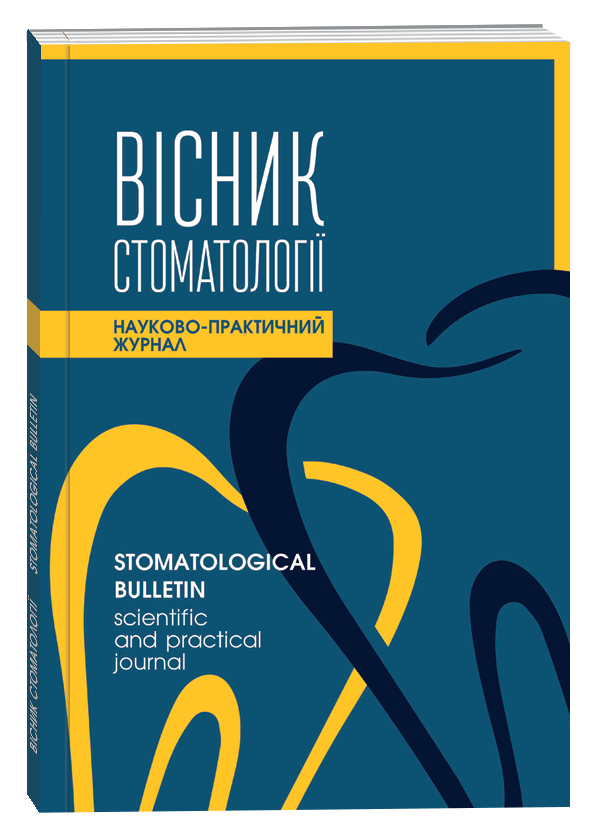ORAL HYGIENE IN CHILDREN WITH MALOCCLUSIONS
DOI:
https://doi.org/10.35220/2078-8916-2019-32-2-62-65Keywords:
children from boarding schools, malocclusions, oral hygieneAbstract
The data of numerous studies show that there is a direct correla-tion between malocclusions and dental caries, periodontal dis-eases, poor oral hygiene, which is manifested by symptoms of mutual complication. The presence of orthodontic pathology (crowding of teeth, anomalies of the position of individual teeth, distal and deep bite) causes accumulation of dental plaque. Spe-cial attention in this aspect deserve children with malocclusions from boarding schools, as many of them are deprived of paren-tal attention, the opportunity to be “grafted” family culture atti-tude to their own health through hygienic oral care.
The aim of our study is to detect the level of hygienic state of the oral cavity in children from boarding schools.
Material and methods. Evaluation of the hygienic state of the oral cavity was carried out in 444 children of boarding schools with malocclusions using the Green – Vermillion hygienic index.
The results of the study. Analysis of the obtained data showed that the average value of the Green-Vermilion index in the ex-amined children is 1.93±0.06 points, which corresponds to a poor level of hygiene. There were established some differences in the value of the index depending on the age of children. Thus, of 7 year-old children, its value was 1.99±0.07 points and up to 9 years of age it increases to 2.09±0.06 points, which indicates deterioration in the oral hygiene. In children of 12 years, the average value of this index is 1.91±0.08 points. It should be not-ed that the lowest index value was recorded in the group of 15-year-old children – 1.72±0.06 points.
We decided to find out how the level of oral hygiene differs in the children of boarding schools with malocclusions depending on their residence. It was established that the worst oral hygiene was found in children of the boarding school of Sambir (premountain area). Thus, a poor level of hygiene was found in children 7 years old (2.44±0.06 points) and 15 years old (2.41±0.08 points). The rest children had a very bad level of hy-giene: 9-year-old and 12-year-old children - 2.71±0.03 points and 2.54±0.07 points, respectively. The children of boarding schools in Lviv and in Zhovtantsy (flat region) of all age groups had poorly care for the oral cavity. At the same time, it was found that the highest level of oral hygiene was in children of Strilki (mountainous region) (1.34±0.08 points) in comparison with other localities, which is explained by the quality educa-tional work of the children's dentist working in this educational institution. We also analyzed the effect of the presence of maloc-clusions on the state of oral hygiene in the examined children. It has been established that in all age groups the presence of or-thodontic pathology significantly affects the state of oral hy-giene. A detailed analysis showed that in 7-year-old children with malocclusions oral hygiene was poor (2.22±0.06 points), and in children without malocclusions - satisfactory (1.69±0.07 points). We also analyzed the indicators of the Green-Vermilion index in children with different types of malocclusions. The highest index values were found in children with anomalies of occlusion – 2.59±0.01 points. The average indexes in children with anomalies of dental arches were significantly lower: 2.38±0.03 points, which also correspond to poor oral hygiene. At the border of satisfactory and poor hygiene, the average val-ues of the index in children with anomalies of individual teeth were 1.89±0.01 points. Thus, the effect of the presence of malocclusions on the level of oral hygiene has been statistically confirmed. A difference was also found in the indicators of oral hygiene in children, depend-ing on the region of examination. With age, the motivation for caring for the oral cavity improves, which is manifested in im-proved hygiene. Also found a relationship between the presence of a dentist in boarding schools and compliance with the rules of oral hygiene, which indicates the role of the dentist in educating children in schools, especially boarding schools.
References
Даулетиярова Ж.Б. Гигиена полости рта при ортодон-тическом лечении / Ж.Б. Даулетиярова // Медицина. – 2013. – №2. – С. 71-73.
Дмитренко М. І. Реакція пародонта на скупченість зубів у дітей / М. І. Дмитренко // Вісник стоматології. – 2004. – № 3. – С. 60-61.
Effect of malocclusion severity on oral health–related quality of life and food intake ability in a Korean population / Sung-Hwan Choi, Jung-Suk Kim, Jung-Yul Cha, Chung-Ju Hwang // American Journal of Orthodontics and Dentofacial Orthopedics. – 2016. Vol. 149, – Issue 3. – P. 384-390.
Олейник Е.А. Скученное положение зубов – зона повы-шенного риска развития основных стоматологических заболеваний / Е.А. Олейник // Институт стоматологии. – 2007. – №3. – С. 62-63.
Суриков А.М. Оценка гигиенического состояния полос-ти рта ортодонтических пациентов / А.М. Суриков // Ортодонтия. – 2005. – №3. – С.17-20.
Каськова Л. Ф. Динамика показателей гигиены полости рта у детей с зубочелюстными аномалиями в процессе проведения профилактических мероприятий / Л. Ф. Каськова, Е. Э. Бережная, О. А. Карпенко // Стоматологическая наука и практика. – 2014. – №1. – С. 27-31.
Дмитрова А.Г. Распространенность и интенсивность ка-риеса зубов у детей раннего возраста в учреждениях для сирот / Дмитрова А.Г., Рогинский В.В., Горбатова Л.В. // Стоматология детского возраста и профилактика. – 2011. т. Х, – № 2. – С.69-72.
Оценка стоматологического здоровья детей – сирот и де-тей, оставшихся без попечения родителей / Л. Н. Казарина, А.Е. Пурсанова, Л. К. Элларян [и др.] // Стоматология детского возраста и профилактика. – 2011. – №2. – С. 67-68.
Методичні рекомендації по статистичній обробці [уклад. Смоляр Н. І., Федорів Я. М. , Завойко Л. М. та ін.]. – Львів. – 1995. – 17с.








